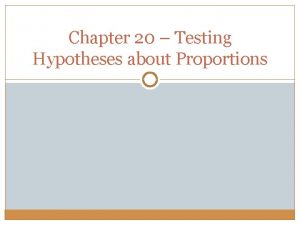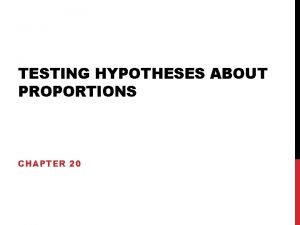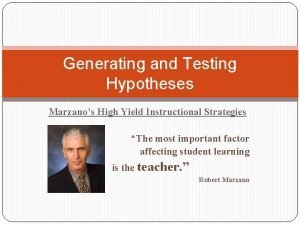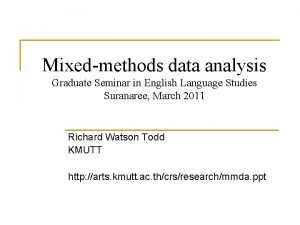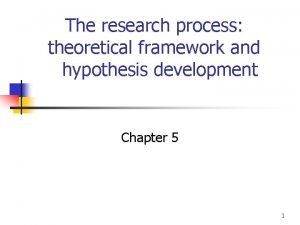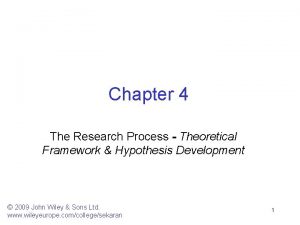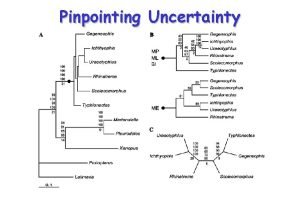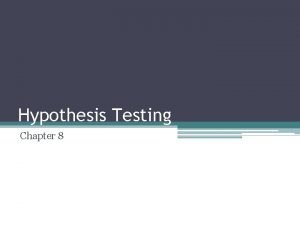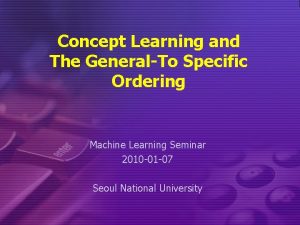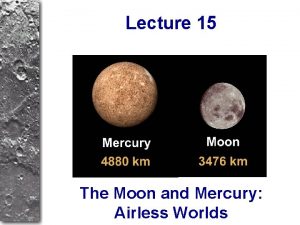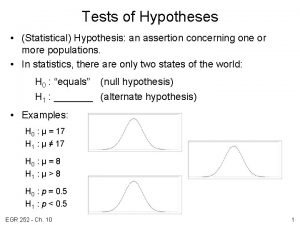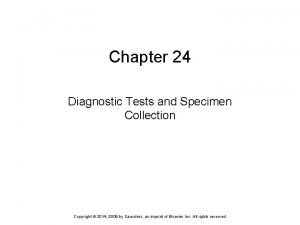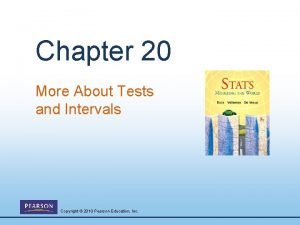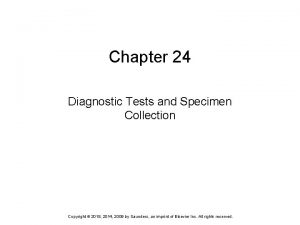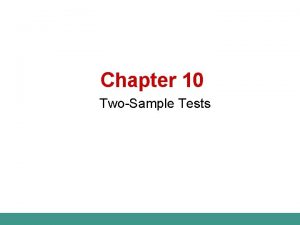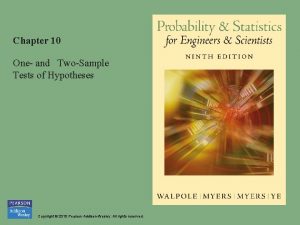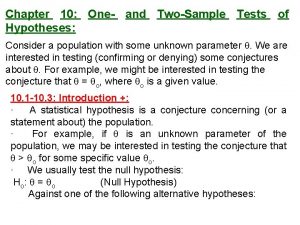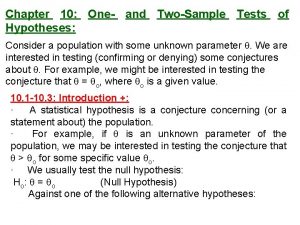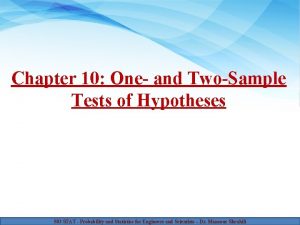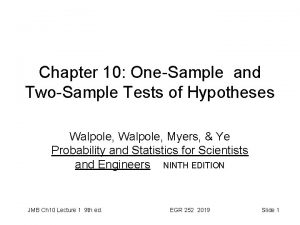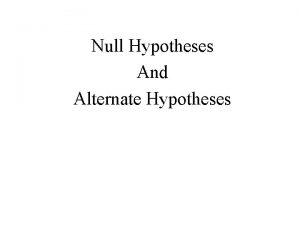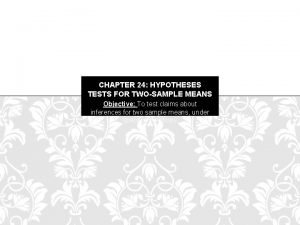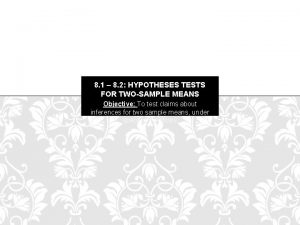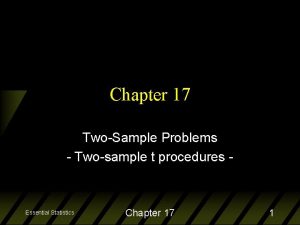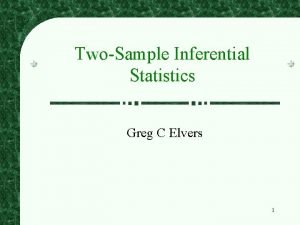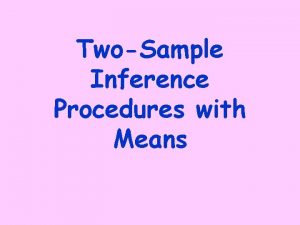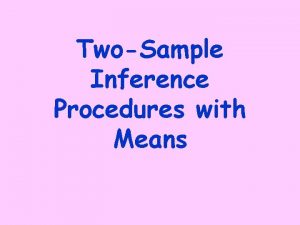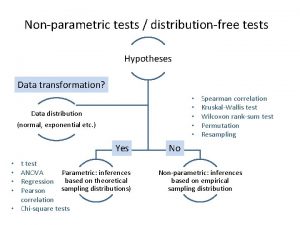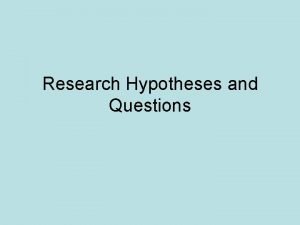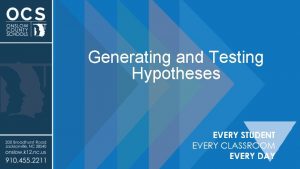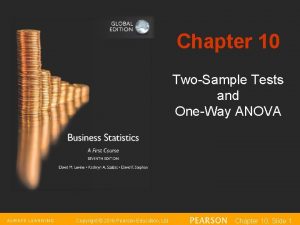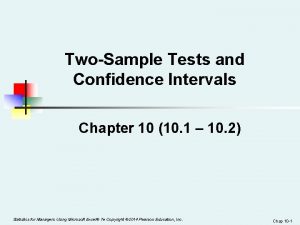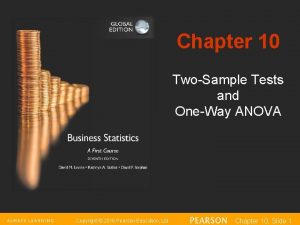Chapter 10 One and TwoSample Tests of Hypotheses























- Slides: 23

Chapter 10: One- and Two-Sample Tests of Hypotheses: Consider a population with some unknown parameter . We are interested in testing (confirming or denying) some conjectures about . For example, we might be interested in testing the conjecture that = o, where o is a given value. 10. 1 -10. 3: Introduction +: · A statistical hypothesis is a conjecture concerning (or a statement about) the population. · For example, if is an unknown parameter of the population, we may be interested in testing the conjecture that > o for some specific value o. · We usually test the null hypothesis: Ho: = o (Null Hypothesis) Against one of the following alternative hypotheses:

o (Alternative Hypothesis H 1: > o or Research < o Hypothesis) · Possible situations in testing a statistical hypothesis: Ho is true Accepting Ho Correct Decision Rejecting Ho Type I error ( ) Ho is false Type II error ( ) Correct Decision Type I error = Rejecting Ho when Ho is true Type II error = Accepting Ho when Ho is false P(Type I error) = P(Rejecting Ho | Ho is true) = P(Type II error) = P(Accepting Ho | Ho is false) =

· The level of significance of the test: = P(Type I error) = P(Rejecting Ho | Ho is true) · One-sided alternative hypothesis: Ho: = o or Ho: = o H 1: > o H 1: < o · Two-sided alternative hypothesis: Ho: = o H 1: o · The test procedure for rejecting Ho (accepting H 1) or accepting Ho (rejecting H 1) involves the following steps: 1. Determining a test statistic (T. S. ) 2. Determining the significance level 3. Determining the rejection region (R. R. ) and the acceptance region (A. R. ) of Ho. R. R. of Ho depends on H 1 and

· H 1 determines the direction of the R. R. of Ho · determines the size of the R. R. of Ho H 1: < o H 1: > o Two-sided alternative One-sided alternative 4. Decision: We reject Ho (accept H 1) if the value of the T. S. falls in the R. R. of Ho , and vice versa.

10. 5: Single Sample: Tests Concerning a Single Mean (Variance Known): Suppose that X 1, X 2, …, Xn is a random sample of size n from distribution with mean and (known) variance 2. Recall: q q Test Procedure:

Hypotheses Ho: = o H 1: > o H 1: < o Test Statistic (T. S. ) R. R. and A. R. of Ho Decision: Reject Ho (and accept H 1) at the significance level if: Z > Z Z < Z Z > Z /2 or Z < Z /2 Two-Sided Test One-Sided Test

Example 10. 3: A random sample of 100 recorded deaths in the United States during the past year showed an average of 71. 8 years. Assuming a population standard deviation of 8. 9 year, does this seem to indicate that the mean life span today is greater than 70 years? Use a 0. 05 level of significance. Solution: . n=100, =71. 8, =8. 9 =average (mean) life span o=70 Hypotheses: Ho: = 70 H 1: > 70 T. S. :

Level of significance: =0. 05 R. R. : Z =Z 0. 05=1. 645 Z > Z =Z 0. 05=1. 645 Decision: Since Z=2. 02 R. R. , i. e. , Z=2. 02>Z 0. 05, we reject Ho at =0. 05 and accept H 1: > 70. Therefore, we conclude that the mean life span today is greater than 70 years. Example 10. 4: A manufacturer of sports equipment has developed a new synthetic fishing line that he claims has a mean breaking strength of 8 kilograms with a standard deviation of 0. 5 kilograms. Test the hypothesis that =8 kg against the alternative that 8 kg if a random sample of 50 lines is tested and found to have a mean breaking strength of 7. 8 kg. Use a 0. 01 level of significance.

Solution: . n=50, =7. 8, =0. 5, =0. 01, /2 = 0. 005 = mean breaking strength o=8 Hypotheses: Ho: = 8 H 1: 8 T. S. : Z /2=Z 0. 005=2. 575 and Z /2= Z 0. 005= 2. 575 Decision: Since Z= 2. 83 R. R. , i. e. , Z= 2. 83 < Z 0. 005, we reject Ho at =0. 01 and accept H 1: 8. Therefore, we conclude that the claim is not correct.

10. 7: Single Sample: Tests on a Single Mean (Variance Unknown): Suppose that X 1, X 2, …, Xn is a random sample of size n from normal distribution with mean and unknown variance 2. Recall: q q q Test Procedure:

Hypotheses Ho: = o H 1: > o H 1: < o Test Statistic (T. S. ) R. R. and A. R. of Ho Decision: Reject Ho (and accept H 1) at the significance level if: T > t T < t T > t /2 or T < t /2 Two-Sided Test One-Sided Test

Example 10. 5: … If a random sample of 12 homes included in a planned study indicates that vacuum cleaners expend an average of 42 kilowatt -hours per year with a standard deviation of 11. 9 kilowatt-hours, does this suggest at the 0. 05 level of significance that the vacuum cleaners expend, on the average, less than 46 kilowatthours annually? Assume the population of kilowatt-hours to be normal. Solution: . n=12, =42, S=11. 9, =0. 05 =average (mean) kilowatt-hours annual expense of a vacuum cleaner o=46 Hypotheses: Ho: = 46 H 1: < 46 T. S. :

=df= n 1=11 t /2= t 0. 05= 1. 796 Decision: Since T= 1. 16 R. R. (T= 1. 16 A. R. ), we do not reject Ho at =0. 05 (i. e, accept Ho: = 46) and reject H 1: < 46. Therefore, we conclude that is not less than 46 kilowatt-hours.

10. 8: Two Samples: Tests on Two Means: Recall: For two independent samples: q If and are known, then we have: q If and are unknown but = = 2, then we have: Where the pooled estimate of 2 is

The degrees of freedom of is =n 1+n 2 2. Now, suppose we need to test the null hypothesis Ho: 1 = 2 Ho: 1 2 = 0 Generally, suppose we need to test Ho: 1 2 = d (for some specific value d) Against one of the following alternative hypothesis 1 2 d H 1: 1 2 > d 1 2 < d

Hypotheses Ho: 1 2 = d H 1: 1 2 d Test Statistic (T. S. ) Ho: 1 2 = d H 1: 1 2 > d H 1: 1 2 < d {if and are known} {if = = 2 is unknown}

R. R. and A. R. of Ho or Decision: or or Reject Ho (and accept H 1) at the significance level if: T. S. R. R. Two-Sided Test One-Sided Test

Example 10. 6: An experiment was performed to compare the abrasive wear of two different laminated materials. Twelve pieces of material 1 were tested by exposing each piece to a machine measuring wear. Teen pieces of material 2 were similarly tested. In each case, the depth of wear was observed. The samples of material 1 gave an average wear of 85 units with a sample standard deviation of 4, while the samples of materials 2 gave an average wear of 81 and a sample standard deviation of 5. Can we conclude at the 0. 05 level of significance that the mean abrasive wear of material 1 exceeds that of material 2 by more than 2 units? Assume populations to be approximately normal with equal variances.

Solution: Material 1 material 2 n 1=12 n 2=10 =85 =81 S 1=4 S 2=5 Hypotheses: Ho: 1 = 2 + 2 (d=2) H 1: 1 > 2 + 2 Or equivalently, Ho: 1 2 = 2 (d=2) H 1: 1 2 > 2 Calculation: =0. 05

Sp=4. 478 = n 1+n 2 2=12+10 2 = 20 t 0. 05 = 1. 725 T. S. : Decision: Since T=1. 04 A. R. (T=1. 04< t 0. 05 = 1. 725), we accept (do not reject) Ho and reject H 1: 1 2 > 2 at =0. 05.

10. 11 One Sample: Tests on a Single Proportion: Recall: q . p = Population proportion of elements of Type A in the population q q n = sample size X = no. of elements of type A in the sample of size n. =Sample proportion elements of Type A in the sample

q For large n, we have ~ N(0, 1) (Approximately, q=1 p)

Hypotheses Ho: p = po H 1: p po Test Statistic (T. S. ) Ho: p = po H 1: p > po H 1: p < po ~N(0, 1) (qo=1 po) R. R. and A. R. of Ho Decision: Reject Ho (and accept H 1) at the significance level if: Z > Z Z < Z Z > Z /2 or Z < Z /2 Two-Sided Test One-Sided Test
 Ace different tests iq tests still
Ace different tests iq tests still Chapter 20 testing hypotheses about proportions
Chapter 20 testing hypotheses about proportions Chapter 19 testing hypotheses about proportions
Chapter 19 testing hypotheses about proportions Chapter 20 testing hypotheses about proportions
Chapter 20 testing hypotheses about proportions Example of hypothesis
Example of hypothesis High-yield instructional strategies
High-yield instructional strategies Examples of mixed methods research
Examples of mixed methods research Hypotheses development
Hypotheses development Give the hypotheses for the following framework
Give the hypotheses for the following framework Theoretical framework hypothesis
Theoretical framework hypothesis Ruling out rival hypotheses
Ruling out rival hypotheses Analysis of competing hypotheses template
Analysis of competing hypotheses template Two types hypothesis
Two types hypothesis General to specific ordering of hypothesis
General to specific ordering of hypothesis Hypotheses
Hypotheses Testing of hypothesis
Testing of hypothesis Hypothesis examples in research
Hypothesis examples in research Twelfth night speeches
Twelfth night speeches One of the most carefully produced assessment tests is the:
One of the most carefully produced assessment tests is the: Chapter 24 diagnostic tests and specimen collection
Chapter 24 diagnostic tests and specimen collection Chapter 20 more about tests and intervals
Chapter 20 more about tests and intervals Chapter 24 diagnostic tests and specimen collection
Chapter 24 diagnostic tests and specimen collection One empire one god one emperor
One empire one god one emperor Little dog run
Little dog run

